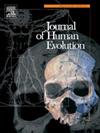Palaeoecology of the Pliocene large carnivore guild at Hadar, Lower Awash Valley, Ethiopia
IF 3.1
1区 地球科学
Q1 ANTHROPOLOGY
引用次数: 0
Abstract
The Hadar Formation at Hadar (Lower Awash Valley, Ethiopia, ∼3.45–2.95 Ma) is one of the most well-known and studied Pliocene hominin-bearing sequences in eastern Africa, yielding numerous fossils of the species Australopithecus afarensis. While much research has been conducted on the palaeoecology of the Hadar Formation broadly, little attention has been placed on the carnivore guild. Here, we present new stable carbon and oxygen isotope data for Hadar carnivores that contribute to the palaeoenvironmental reconstructions of the Hadar Formation and facilitate inference of predator-prey relationship between the large carnivore and herbivore guilds at Hadar. Overall, the members of the Hadar carnivore guild had relatively high carbon values (−4.6 ± 1.4‰), with the highest values in the middle part of the sequence (Denen Dora Member, ∼3.2 Ma). These values are higher than the carbon values of carnivores from penecontemporaneous sediments in the Turkana Basin (southern Ethiopia and northern Kenya). Stable oxygen isotope values are variable throughout the Hadar Formation, but reconstruction of estimated meteoric water oxygen values indicates a wetter and more pluvial climate than that at the present. Carbon isotope mixing models weighted by a prey selectivity index based on established predator-prey body size relationships reveals that two large-bodied taxa (Homotherium and Crocuta venustula) had partitioned their dietary niches only to a limited extent. Understanding the nature of the large carnivore guild at Hadar allows us to predict which taxa may have been competitors or predators of Au. afarensis, offering insights into the palaeoecological context beyond what can be inferred from palaeoenvironmental reconstructions alone. Moreover, our analyses provide a valuable insight into the little-known isotopic ecology of fossil African carnivores.
埃塞俄比亚下阿瓦什河谷哈达尔地区上新世大型食肉动物公会的古生态学
Hadar组(埃塞俄比亚下阿瓦什山谷,约3.45-2.95 Ma)是非洲东部最著名和研究最多的上新世人类序列之一,发现了大量的南方古猿阿法种化石。虽然对哈达尔组的古生态学进行了广泛的研究,但对食肉动物行会的关注却很少。本文提供了新的哈达尔食肉动物的稳定碳氧同位素数据,有助于重建哈达尔组的古环境,并有助于推断哈达尔大型食肉动物和食草动物行会之间的捕食-猎物关系。总体而言,哈达尔食肉动物行会成员的碳值相对较高(- 4.6±1.4‰),其中序列中部(Denen Dora成员,~ 3.2 Ma)的碳值最高。这些值高于图尔卡纳盆地(埃塞俄比亚南部和肯尼亚北部)准同生沉积物中食肉动物的碳值。稳定的氧同位素值在整个哈达尔组是变化的,但估计的大气水氧值的重建表明,气候比现在更湿润,更富雨。基于已建立的捕食者-被捕食者体型关系的碳同位素混合模型加权表明,两个大型类群(Homotherium和Crocuta venustula)仅在有限程度上划分了它们的饮食生态位。了解哈达尔大型食肉动物公会的性质,可以让我们预测哪些分类群可能是Au的竞争对手或捕食者。阿法种,提供了对古生态背景的深入了解,而不仅仅是从古环境重建中推断出来的。此外,我们的分析为鲜为人知的非洲食肉动物化石的同位素生态学提供了有价值的见解。
本文章由计算机程序翻译,如有差异,请以英文原文为准。
求助全文
约1分钟内获得全文
求助全文
来源期刊

Journal of Human Evolution
生物-进化生物学
CiteScore
6.30
自引率
15.60%
发文量
104
审稿时长
3 months
期刊介绍:
The Journal of Human Evolution concentrates on publishing the highest quality papers covering all aspects of human evolution. The central focus is aimed jointly at paleoanthropological work, covering human and primate fossils, and at comparative studies of living species, including both morphological and molecular evidence. These include descriptions of new discoveries, interpretative analyses of new and previously described material, and assessments of the phylogeny and paleobiology of primate species. Submissions should address issues and questions of broad interest in paleoanthropology.
 求助内容:
求助内容: 应助结果提醒方式:
应助结果提醒方式:


